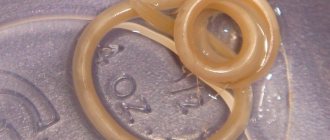Foaming from a dog's mouth is a dangerous symptom that may indicate the development of serious diseases. If you do not pay attention to negative signs in a timely manner, the dog’s life may be in danger. Foaming at the mouth can also be a physiological phenomenon, but to be on the safe side, it is still better to visit a veterinarian and undergo a comprehensive examination if your dog periodically has discharge from the mouth.
The dog is foaming at the mouth
Why does foam appear at the mouth?
If the puppy begins to foam at the mouth, this may indicate the development of serious internal pathologies, which often become a threat to the pet’s life. However, it happens that a foam-like substance from the mouth is a reaction to some stressful situation and is not dangerous.
Physiological phenomena
If we talk about physiological processes, foam from a dog’s mouth can drain as a result of:
- strong emotional shocks, stress (for example, death of the owner);
- long stays on the road, long walks on the street in the heat (foam appears against the background of motion sickness);
- getting irritating substances into the mouth (for example, too bitter tablets);
- foreign objects getting into the mouth;
- conditions after operations (discharge from the mouth - a reaction to anesthesia).
Important! Foamy discharge can also be a reaction to prolonged refusal of food. White foam at the mouth can also occur if the dog ate too much food and did not have time to chew it thoroughly. Food that is literally swallowed whole leads to indigestion and the appearance of negative symptoms.
Pathological conditions
In most cases, foaming at the mouth indicates the progression of diseases and conditions such as:
- Poisoning. This condition is characterized by: increased salivation, nausea, yellow and white discharge from the mouth, vomiting, problems with stool. The animal's body temperature may rise and convulsions may appear.
- Cardiac pathologies. Foam from the mouth can form due to a lack of oxygen in the body. This is one of the signs of heart problems. There may be other symptoms at the same time. For example, heavy breathing, cough, cramps.
- Brain pathologies. Discharges appear due to brain injuries and circulatory disorders. In this case, in addition to a foamy substance from the mouth, pets begin to vomit.
- Worm infestation. The disease is most often accompanied by a cough, sudden weight loss, problems with swallowing food, loss of appetite, and the appearance of discharge in the anus.
- Epilepsy. If foam from the mouth is accompanied by fainting and convulsions, this indicates the occurrence of an epileptic seizure. The disease is neurological in nature and practically cannot be treated, especially at home. But if you conduct an examination in time, you can maintain the animal’s condition and reduce the number of attacks.
Foamy discharge from the mouth of animals
Foamy discharge can be a sign of a progressive infectious disease (enteritis, rabies).
How to warn?
Many of the causes that cause foaming at the mouth can be prevented. To do this, carry out simple activities:
If you are foaming at the mouth due to nausea in transport, then you need to train the vestibular apparatus. It is recommended to ride short distances at first, gradually increasing the mileage. Start when you are a puppy and train more often. You can give anti-sickness medication before the trip.
- Carry out deworming and routine vaccinations in a timely manner.
- Keep toxic substances, including household chemicals, out of reach.
- It’s better to take care of your pet on a walk, very often dangerous objects and poison are picked up by dogs there.
- Apply flea treatment strictly to the areas indicated in the instructions to avoid licking.
Having studied this information, you will be able to prevent a dangerous situation as much as possible, and if something does happen, you will be fully armed. Health to your pets!
Is it dangerous
Although foam from the mouth of dogs in some cases does not cause a threat to life, when it appears, it is necessary to show your pets to a veterinarian. Perhaps discharge is the first sign of a serious disease that requires complex treatment. If there is no reason for concern, the doctor will give his recommendations to eliminate repeated cases of foam-like substance appearing from the mouth.
When foam is a symptom of illness
If light, bubbly discharge is an independent symptom and does not have a negative effect on the pet’s condition, it may have appeared as a physiological reaction to an external irritant. If negative symptoms appear frequently and are accompanied by other signs that negatively affect the dog’s condition, then it is advisable to contact a veterinarian. You can tell that your pet is in danger by symptoms such as:
- nausea;
- vomit;
- diarrhea, diarrhea, yellow discharge from the anus;
- change in the condition of the stool (appearance of blood streaks);
- convulsive conditions;
- dry cough;
- redness of the oral mucosa;
- disorientation;
- apathy;
- loss of appetite.
Important! If the dog begins to lose weight sharply and changes in behavior, this may also indicate a serious illness.
Associated symptoms
Concomitant symptoms before the appearance of foamy discharge from the mouth may include:
- weakness;
- loss of appetite;
- hiccups;
- cough.
The dog may also experience an increase in temperature and seizures.
What dog breeds are at risk?
Veterinarians say that dogs of both small and large breeds are at risk: terrier, Labrador, beagle, sheltie, keechonde, poodle, St. Bernard.
Foam from the dog's mouth
Reasons that may cause foaming at the mouth
The foamy liquid is a mixture of mucus and saliva. Each of these components plays an important role in the functioning of the canine body. Mucopolysaccharides and protein components included in the mucus form bubbles when mixed with saliva and air. This chemical reaction frightens animal owners.
There are many reasons why a dog may foam. Traditionally, they can be divided into two categories – physiological and pathological. The first type can occur even in healthy pets. In any situation, it is necessary to remember that foam mass is not a disease, but a symptom that is important to take into account to make a diagnosis. That is why, when such a sign appears, immediately go to a specialist who can correctly determine what is causing it. Let us consider in detail the most common physiological root causes.
Motion sickness in the car
Driving for a long time in a car or any other form of transport can lead to the release of a viscous secretion consisting of foam, mucus and saliva. Foam from the mouth of a domestic dog as a result of motion sickness is a reason to contact a veterinarian. The specialist will select the right medications and prescribe a course of therapy. Weight (small or large dog), breed and age must be taken into account. It is also very important to tell the doctor how long after the start of the trip motion sickness appears and its clinical picture.
After anesthesia and surgery
Any surgical intervention and other medical procedures are accompanied by the administration of anesthesia. Like humans, animals can have difficulty recovering from the effects of medications. The body of four-legged pets tries to protect and protect the brain from various components that are part of anesthesia. For this reason, dog owners may notice the appearance of vomiting with foam, tremors of the limbs, diarrhea, and a decrease in body temperature. Provided there are no pathological complications, such symptoms disappear after all components of the administered drug are removed from the dog’s body.
First aid
What should an owner do if a pet has foamy discharge?
- If the dog has not eaten for a long time, you can give him some plain water and then feed him low-fat food. Perhaps the negative symptoms appeared as a result of a long fast.
- If your dog develops diarrhea or bleeding from the anus, you need to prepare him plenty of fluids, avoid eating fatty foods, and call a doctor. Such symptoms may indicate the progression of helminthic infestation.
- If your pet is having an epileptic seizure, you should lay him on his side, holding his head. As soon as the attack passes, you need to go to the veterinarian for an examination.
Causes and types of canine seizures
Convulsions occur due to a malfunction of neurons that transmit nerve impulses from the brain to the muscles. Abnormal electrical flashes in brain structures can occur due to many different reasons.
In a healthy body, all atypical brain activity is blocked. In the presence of serious illnesses, impulse blocking mechanisms do not work, resulting in severe muscle spasms and limbs that may twitch.
Seizures in dogs vary in the nature and frequency of contractions:
- convulsive (jerky contractions, similar to twitching);
- tonic (slow and prolonged contractions of the hind limbs);
- clonic (frequent contractions alternating with relaxation);
- epileptic (accompanied by loss of consciousness).
The intensity of the seizure can be either mild (twitching of the paw) or severe (the dog falls to the floor, the whole body contracts, loss of consciousness is possible).
The intensity of the seizure can range from mild to severe
Is there any prevention
Basic preventive measures to prevent foamy discharge from a dog’s mouth:
- Get all the necessary vaccinations for your pet.
- Feed the animal correctly: avoid overeating and prolonged fasting.
- Include vitamin and mineral supplements in your diet.
- Use physical activity in moderation (running, training for competitions).
Important! Owners need to regularly (at least twice every six months) bring the dog to the doctor for examination and examination.
Foam and mucus from a dog's mouth is a symptom that may indicate the development of heart disease, epilepsy, and food poisoning. It may also be a physiological phenomenon. Sometimes bubbly light discharge appears as a reaction to heat, active physical activity, or prolonged fasting. Only a veterinarian can determine the exact cause of the symptoms.
Associated symptoms
Record each of the accompanying symptoms in detail. They will help the veterinarian during diagnosis.
Shaking your head
If your pet shakes its head, check its mouth. He may be trying to get rid of stuck wood chips or other foreign objects.
Convulsions
If your dog is foaming at the mouth and has convulsions, the cause may lie in an epileptic seizure or poison intoxication. Convulsions in epilepsy are accompanied by involuntary urination and bowel movements, as well as complete disorientation in space. In case of poisoning, dilation of the pupils and a decrease in body temperature are noted.
Vomiting and gastrointestinal upset
If your dog comes out of his mouth not only with foam, but also with vomit, examine the color and consistency of the vomit. This will be needed when collecting anamnesis.
When an animal vomits, it is often tormented by painful spasms and diarrhea. Such symptoms are extremely dangerous for puppies, as they quickly dehydrate the body.
Heart rhythm disturbances
Count your heart rate or the number of breaths you take in minutes. Rapid breathing may cause cardiac arrest, so contact your veterinarian for further advice.
What is foam coming from a dog's mouth?
The liquid, foam-like substance is a mixture of saliva and mucus. Mucus coats the walls of the stomach, protecting it from aggressive gastric juices that can harm the dog. It is formed even in an empty stomach.
Mucus consists of many substances, including mucopolysaccharides and proteins. When it mixes with saliva, a chemical reaction of enzymes with air occurs, resulting in the formation of scary bubbles.
The discharge of a foamy mass is often accompanied by nausea. In other cases, foaming occurs without vomiting, which may indicate disorders of the digestive system and many other conditions.
In fact, the foam itself is not dangerous, since it is saliva with mucus. If cases of its release are rare, we may be talking about digestive problems. However, if attacks become more frequent, owners should pay attention to the health of their dog, monitor other symptoms and be sure to contact a veterinarian.
Treatment
If a foreign body is stuck in your dog's mouth, you can put on rubber gloves and try to pull it out with your fingers.
If this is not possible, the pet is taken to the veterinarian. If your dog gets sick in the car, just take him out into the fresh air. If your dog has foamy discharge with blood in it, it is necessary to take it to the vet immediately. In case of food poisoning, cleansing the stomach by inducing vomiting and taking enterosorbents is indicated. If the cause of the illness is poison, you will need a specific antidote, as well as blood purification. In this case, inducing vomiting is contraindicated. Before the doctor arrives, you must ensure that your pet’s tongue does not block the airway during convulsions.
If there is a suspicion of a heart attack, the dog must be taken to the clinic; it is first recommended to give an injection of a heart drug. If a dog starts foaming at the mouth due to rabies, there is no chance to save it. You can only alleviate the dog’s suffering by putting him to sleep in the clinic.











